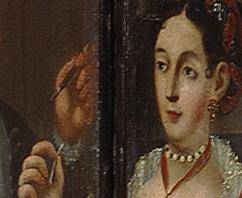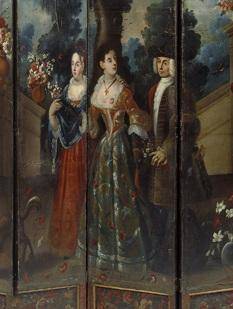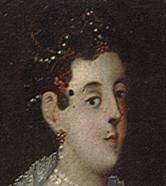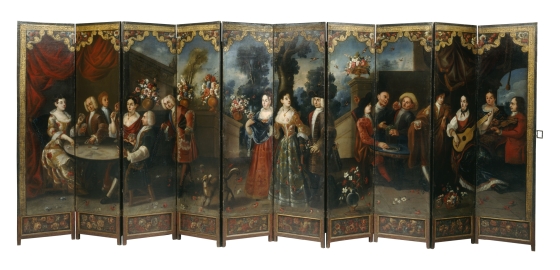Students will observe and visually critique the image of Garden Party on the Terrace of a Country Home, paying particular attention to the artist’s use of expressive features of art and design. Students will show evidence of their learning by creating their own crowd scene, showing depth of space and emotion.
Students will be able to:
- describe and analyze what they see in Garden Party on the Terrace of a Country Home;
- identify the artist’s use of characteristics and expressive features of art and design; and
- demonstrate learning by creating an image using the illusions of depth of space and illustrating emotion in a crowd.
Lesson
- Show students the image of Garden Party on the Terrace of a Country Home. Have students describe what they see. Relate what they see to any styles of art they have seen before.
- Ask them if they are able to identify any clues as to the culture or age of the object. It might surprise them to know it is from the 1720-1730s in Mexico City, Mexico. Ask students if they are surprised by this information and, if they are, why.
- Share the information from the About the Art sheet with the students and discuss the Spanish Colonial period of Latin America that took place from 1521-1821. At this time Spain was a dominant influence of the culture of Mexico, in particular Mexico City.
- Show students the “Things to Look For “information and locate those things in the painting. Ask students if they can identify the setting or where this group of people is. Ask students to describe what is going on in this picture.
- How many people are at this gathering? How are the people in the group feeling about being there? How can you tell these things? What has the artist done to show us how people feel? Discuss how artists use facial emotions, physical gestures, and color to show mood.
- How has the artist shown us that this is a crowd of people? Discuss the characteristics of the visual illusions of depth of space, focusing on atmospheric perspective, overlapping, and strategic placement.
- Have students think of the last time they were in a crowd where there were groups of happy people. Could it have been a Rockies game? A picnic at the park? A birthday party?
- Invite students to draw a scene they have experienced showing a crowd of people. Remind them to use depth of space and overlapping to show the many people in the crowd and to use artists’ tricks of how to show emotion in their drawings.
Materials
- Sketch paper
- Drawing paper
- Pencils with erasers
- Variety of colored pencils and markers
- Optional: scenes and images of crowds
- Color copies of the screen for students to share (found at the end of the lesson plan) or the ability to project the image onto a wall or screen
- Copies of the About the Art sheet on the Garden Party on the Terrace of a Country Home, or student access to this part of Creativity Resource online
Standards
- Visual Arts
- Collaboration
- Critical Thinking & Reasoning
- Information Literacy
- Invention
- Self-Direction
Garden Party on the Terrace of a Country Home
- unknown artist
Although we do not know the name of the artist(s) who created this screen, we do know that it was made in Mexico City sometime between 1720 and 1730. During this time, Mexico was part of the area governed by Spain in the New World. The Spanish Colonial period in Latin America lasted for 300 years, from 1521 to 1821. By 1598, the Spanish empire in the Americas spread from present-day southern Colorado to the tip of South America (excluding Brazil). The resulting culture and art is a combination of the European and indigenous cultures. Spanish Colonial artists were also greatly influenced by Asian art, which they encountered through trade.
Folding screens or “Biombos” (bee-ohm-bows) were used in homes to divide spaces, block drafts, and provide privacy. The folding screen form was invented in China, perfected in Japan, and introduced to the Western world through trade in the late 1500s. By the early 1700s, a new genre of screen was invented in Mexico City. Partially derived from a fashion for pastoral paintings in Europe, screen painters began to depict scenes of upper and middle class people enjoying a leisurely afternoon on the garden terrace of a country home. There are only about a dozen screens like this known today, and all were made in Mexico City in the 1700s. These screens provide a glimpse into upper-class life and recreation in Mexico in the 1700s, during the season of summer parties. As is the case with most garden party screens, the people on the left appear more richly or more formally dressed than those on the right. The precise social reason for this is still unknown. It may indicate that both upper and middle class people participated in these festivities. Or it may represent the upper class owners of the summer home and their guests on the left, and the servants or employees, also participating in the festivities, on the right.
Details

Card Players
On the far left, men and women dressed in party clothes sit around a table playing cards. The coins and small beans on the table indicate that they are gambling. The cards they use are an older design—the clubs are actual wooden clubs, the spades are daggers, the hearts are a cup or chalice, and the diamonds are gold coins.

Smoking
The woman on the right side of the table holds a cigarette in her right hand, and the man behind her holds what appears to be a cigar. Tobacco was a New World product and was unknown in Europe before contact with the Americas. In Europe, usually only men smoked tobacco, but in the Americas it was completely acceptable for women of all classes to smoke.

Music
On the right side of the screen a woman sings and plays a distinctive Mexican guitar. The man next to her is playing a violin or fiddle while another woman appears to sing.

Scarves
Both women in the band wear the distinctive Mexican striped rebozo, or rectangular shawl, which is still made in Mexico today. The woman with the guitar also wears a paňuelo, a triangular scarf tied around her neck. This type of scarf was worn by both men and women in Mexico and eventually evolved into the cotton bandanna worn by cowboys.

Clothing
The clothing is faithful to the era. All of the women wear full skirts, fitted bodices, elbow-length sleeves, and lace ruffles at the cuffs and necklines. The also wear elaborate jewelry made from gold, pearls, and other stones. The men on the screen all wear knee breeches, stockings, white shirts, and coats of the period. The men also wear powdered white wigs.

Beauty Marks
Many of the women wear fake beauty marks called chiqueadores. The marks are made from black velvet or tortoiseshell and placed on the women’s temples. Fake beauty marks were very fashionable among women in Europe and the Americas at this time.
Funding for object education resources provided by a grant from the Morgridge Family Foundation. Additional funding provided by the William Randolph Hearst Endowment for Education Programs, and Xcel Energy Foundation. We thank our colleagues at the University of Denver Morgridge College of Education.
The images on this page are intended for classroom use only and may not be reproduced for other reasons without the permission of the Denver Art Museum. This object may not currently be on display at the museum.







